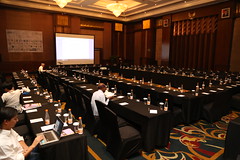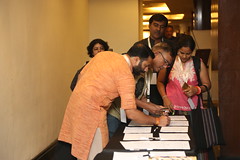Credit: Rucha Chitnis
At sunset, Bibiana Ranee sets out to gather wild edibles for dinner from the surrounding forest. She returns with bright bunches of greens. Jarain and jali are washed, sliced, sauteed, and served with a hearty pork stew, with raw tree tomato on the side.
Ranee, 54, is proud of her ancestral roots: She’s a member of the Khasi tribe, which nestles high in the mountains of Meghalaya, a state in northeast India. All three major tribes of Meghalaya—Khasi, Garo, and Jaintia — are matrilineal. Children take the surname of the mother’s clan and girls inherit traditional lands — the youngest daughter typically receiving the largest share.
To reach her home in the village of Nongtraw in East Khasi Hills, Ranee must make her way down a steep mountain via some 2,500 meandering steps. Her front porch is adorned with rosy hues of amaranth, an ancient grain cultivated for more than 8,000 years. “When I was five years old, my mother took me to the fields,” Ranee says. “I learned about the foods in the fields and the forest from her.”
Across India, indigenous women step up to the plate in myriad ways: In Meghalaya, indigenous women are keepers of the seeds that form the foundation of their food sovereignty, a conscious choice by small food producers to define their unique food systems and culture. Indigenous women are also holders of traditional knowledge that enables them to gather medicinal plants and wild edibles in the surrounding forests, and gives them deep understanding of the ecology.
“Women are conservers of seeds and know when each grain has to be sown,” says Patricia Mukhim, a prominent Khasi journalist and editor of The Shillong Times. “They exchange seeds, and if today we still have been able to conserve the indigenous seed species, which are hardy and can resist the vagaries of climate change and its extreme temperatures, then women are singularly responsible for that conservation effort.”
While a majority of rural women in India struggle for land ownership, as well as recognition of their immense contributions as farmers, Khasi women are valued as food producers in their families and larger community. “Since [Khasi] women own land they can also control what crops and vegetables to grow and what livestock to rear,” Mukhim says.
Ranee grows more than 32 food crops in her field and home garden, an astonishing diversity that’s in stark contrast with the wheat and rice monocultures that were promoted during India’s Green Revolution.
She names three varieties of yams, four varieties of millet, two varieties of tapioca, and a medley of other vegetables — pumpkins, cucumbers, wild potatoes, beans, and sesame that diversify her food basket. Her home garden has rich offerings — a natural pharmacy with an abundance of medicinal herbs and shrubs, along with vegetables and fruit trees. The surrounding forest adds to the nutritious bounty, offering wild greens, nuts, medicinal plants, fruits, and mushrooms.
Dr. Daphne Miller is impressed by the biodiversity of food that is nurtured and sustained by indigenous women in Nongtraw.
“When I wandered around the village, I found plants that are very good at lowering blood sugar,” says Miller, who studies the world’s healthiest diets and is the author of Farmacology. “The foods are herbs — wild foods that are medicinal in their qualities for lowering blood pressure, blood sugar, stress.”
Nongtraw farmers, like Ranee, are proud that their village has sustained its traditional organic farming practices in spite of industrial agriculture entering the state. Ranee says that some farmers tried using chemical fertilizers on small plots of land when the government promoted them, but later refused. “My mother told me to grow food without fertilizers,” Ranee says.
“What indigenous famers do is they follow the rules of nature,” Miller says in an interview with Indigenous Rights Radio. “They have a huge amount of biodiversity within their land, they use dozens of different seeds. They are not just organic—they are regenerative. They are organic plus!” Ranee concurs and is proud that all her children value their indigenous food systems and understand that the health of the surrounding forest and river is key for their health and well-being.
While indigenous farmers in Nongtraw refrain from using chemical fertilizers and pesticides, the pressures of industrial agriculture loom large. Rice monocultures are increasing in Meghalaya, as is the influence of the market economy.
Women in matrilineal Meghalaya are also politically marginalized and as land becomes a scarce and valued commodity, instead of a community resource, new challenges are surfacing for Khasi women. Ranee has joined the North East Slow Food & Agrobiodiversity Society (NESFAS) to celebrate traditional farming practices that conserve the vast biodiversity of foods found in their forests and traditional jhum fields (an ancient shifting cultivation method) and raise awareness of the vital links with indigenous culture and food sovereignty.
Last November, Meghalaya hosted Indigenous Terra Madre, a gathering of 140 food communities from 58 countries. Ranee and others from Nongtraw attended a food festival that was attended by more than 60,000 people across northeast India and beyond.
At the festival, indigenous foods, seeds, harvest songs, and dances exhibited how a deep relationship with land and biodiversity is linked with stunning cultural richness. Reflecting on their way of life, Ranee remarked: “We may not have a lot of money, but we have plenty of food. We are happy, because we live in peace and harmony with Mother Earth.”
The Khasi tribe in the northeastern state of Meghalaya in India is matrilineal, where children take the last name of the mother’s clan. Unlike other parts of India, where women struggle to access land rights, Khasi women inherit land, the youngest daughter typically receiving the largest share.
Bibiana Ranee is proud of her Khasi lineage and indigenous roots. She is a strong advocate for local food systems and agrobiodiversity, where indigenous knowledge systems are preserved and celebrated.
“In matrilineal societies of Meghalaya like the Khasi, women are considered important partners like their male counterparts in any kinds of agrobiodiversity activities. If the land is ancestral or clan land, women are the custodian of such lands. Women have a distinctive part in the agrobiodiversity life and their contributions toward income generation and food security is recognized in Khasi society,” says Dr. A. K. Nongkynrih, Professor of Sociology at North-Eastern Hill University in Shillong, Meghalaya.
Karamela Khongran grows more than 35 varieties of crops in her jhum field, an ancient shifting cultivation method practiced widely in northeast India. “Being from a matrilineal system, I am respected as a woman,” she says.
“There are ceremonies attached to the sowing and harvesting season. Each grain is seen as a blessing from nature and what is conserved naturally is often more treasured than those given by the agriculture and horticulture departments, which are soaked in chemicals for preservation,” notes Patricia Mukhim.
Khongran harvests sesame seeds from her jhum field. “If I grow just one crop, where would I get rest of our food from?” she asks, noting her reservations about monocultures.
Women are also the seed savers, playing a vital role in preserving the immense agrobiodiversity of the region. Farmers in Nongtraw have also revived their tradition of growing millet — a nutritious grain that was marginalized by India’s Green Revolution.
“Women are conservers of seeds and know when each grain has to be sown. They exchange seeds and if today we still have been able to conserve the indigenous seed species, which are hardy and can resist the vagaries of climate change and its extreme temperatures then women are singularly responsible for that conservation effort,” Mukhim says.
Ranee’s home garden has many medicinal plants. In this photo, a relative shows how his wound was healed using a combination of two plants from the garden that are known for their blood-clotting properties.
Another herb, kynbat pallon, in Ranee’s garden is used to cure stomach ailments.
Traditional varieties of hill paddy are in decline in many parts. But there’s hope for revival; 14 varieties of local rice were found in a Jaintia village and food justice groups are working to revive more varieties.
11 varieties of indigenous fish are found in a river that flows below Nongtraw. Communities use baskets to catch the fish, and fishing is regulated by village rules.
Ranee believes it’s important to instill pride in indigenous youth in their unique food culture and deep connection with nature.
Indigenous dancers showcase their traditional harvest dances at Indigenous Terra Madre in Shillong, Meghalaya in November.
This story was originally published by YES!, a nonprofit publication that supports people’s active engagement in solving today’s social, political, and environmental challenges.









































